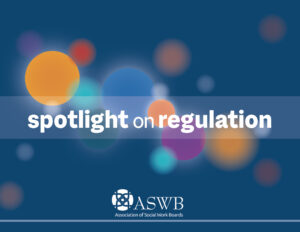Regulatory data in the spotlight
Building understanding about social work regulation and promoting consistency in standards are dual goals of a recent collaboration between ASWB’s Member Engagement and Regulatory Services department and marketing staff.
 A new resource, Spotlight on Regulation, is now available on aswb.org. It features graphically presented information and interactive maps that supplement the dynamic laws and regulations database reporting tools that have long been available on the site.
A new resource, Spotlight on Regulation, is now available on aswb.org. It features graphically presented information and interactive maps that supplement the dynamic laws and regulations database reporting tools that have long been available on the site.
The new resource provides snapshots of jurisdiction requirements that quickly convey key information to users. Marketing and Design Project Coordinator Kim Phillips distilled 30 huge spreadsheets into attractive and accessible graphics for each jurisdiction. The page also presents interactive maps created by Regulatory Support Services Program Manager Cara Sanner using Tableau software. “The maps provide high-level data snapshots of licensing and continuing education requirements and the number of social workers licensed/registered in individual jurisdictions,” Sanner said.
Members may use Spotlight on Regulation to look up requirements and other information or share it with their licensees to help address questions and educate about regulatory requirements. Other groups will also find the resource useful. “ASWB regularly answers questions and provides information to the public, social workers, and stakeholders, such as the academic community, agencies that employ social workers, and social work professional associations,” Sanner said.
When looking at requirements from a high level, which these resources do, there are far more similarities than there are differences.
Beyond the project’s educational purpose, Senior Director of Member Engagement and Regulatory Services Jennifer Henkel said Spotlight on Regulation will help ASWB fulfill one of the objectives of the new strategic framework: strengthening consistent standards across jurisdictions. “The new strategic framework emphasizes increased consistency—a goal that’s been in place since the Model Social Work Practice Act was first published in 1997,” Henkel said. “That’s important because consistency across jurisdictions benefits consumers, policy makers, employers, and regulated social workers.”
Sanner believes the resource reveals that jurisdictions largely regulate social work in similar ways. “There is a great deal of uniformity as to how jurisdictions regulate social work,” she said. “When looking at requirements from a high level, which these resources do, there are far more similarities than there are differences.”
ASWB plans to update Spotlight on Regulation quarterly, adding new features and basing revisions on information gathered through reviewing social work statutes, regulations, policy documents, and related materials; monitoring for changes with a tracking service hosted by LexisNexis; and interacting with member jurisdictions and stakeholders.

